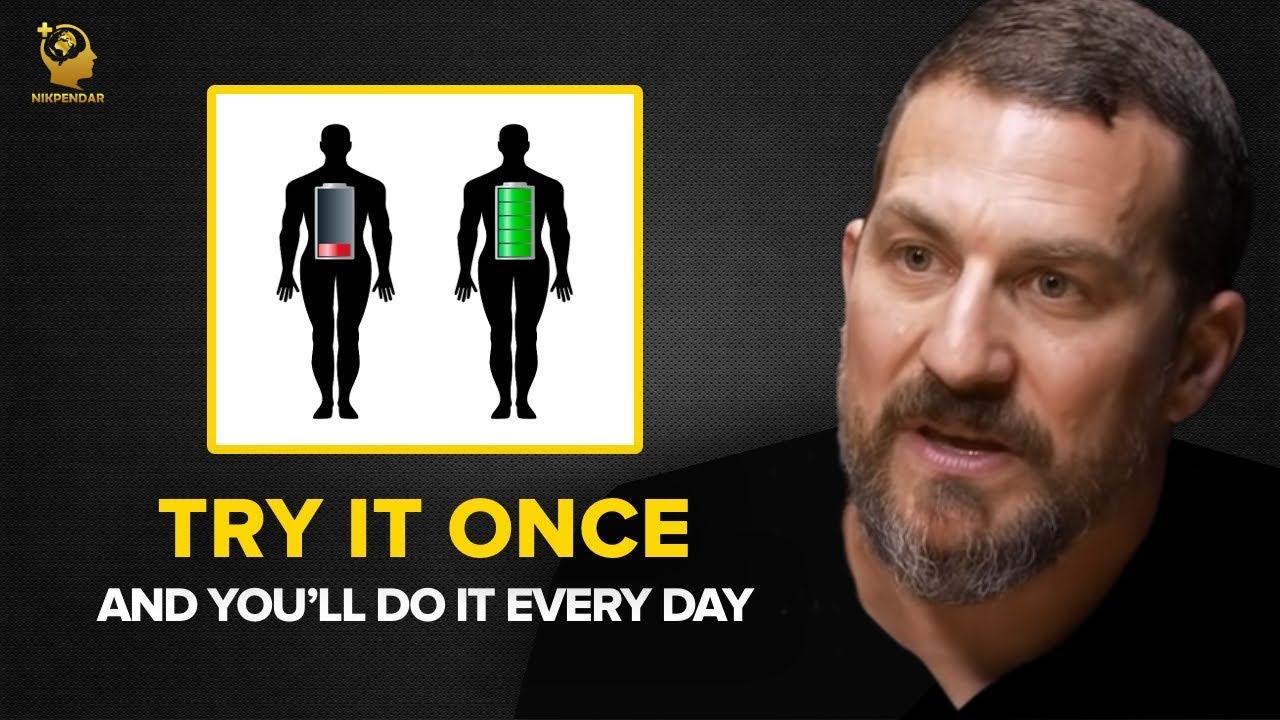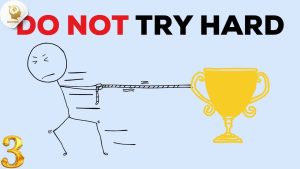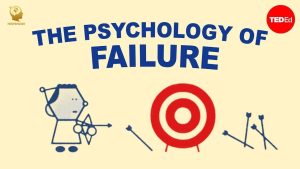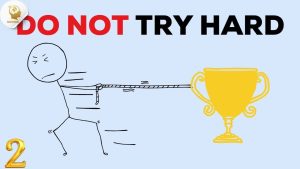
Beginner
- Task 1: Describing a Feeling. Students will be shown an image of a person looking frustrated or tired. They must describe how the person feels using words from the videolike painful, hard, or effort. This task helps them connect new vocabulary to a visual cue and express a simple emotion.
- Task 2: Giving Simple Instructions. Students will be asked to give one simple piece of advice based on the video ‘s tools. For example, “What is one thing you can tell yourself when something is hard?” They should respond with a phrase like, “I can tell myself the effort part is the good” This focuses on using new verbs and vocabulary in a directive context.
- Task 3: Role-Play: Offering a Simple Solution. In pairs, one student will act out a difficult task (e.g., pretending to study a hard subject). The other student will offer one piece of simple advice from the video , such as “Don’t focus on the end goal” or “Focus on the effort.” This task helps them practice using target language in a practical, conversational scenario.
Intermediate
- Task 1: Explaining an Experiment. Students will be asked to explain the experiment with the children and the gold stars. They should explain to a partner what the children were doing, what the researchers did, and what the outcome was. They should use specific words from the text like intrinsic and extrinsic reinforcement to describe the concepts.
- Task 2: Creating a Scenario. Students will be given a situation (e.g., “You are training for a race”). They must create and act out a short scenario where they describe their challenge using language from the video(e.g., “This feels so painful“), and then explain how they will use the speaker’s advice to get through it. This promotes creative application of the language.
- Task 3: Discussion: Growth Mindset. Students will work in a small group to discuss the concept of a growth mindset. They should prepare to state their own opinion and use at least two key phrases from the videoto support their view, such as “striving itself is the end goal” or that it “delivers you to tremendous performance.”
Advanced
- Task 1: Delivering a Short Presentation. Students will prepare and deliver a short talk (2-3 minutes) on one of the main topics in the video , such as the relationship between dopamine and effort, or the difference between intrinsic and extrinsic motivation. They must use the target vocabulary accurately and present the information in a clear, well-structured way.
- Task 2: Debating a Topic. Students will work in pairs to debate the speaker’s advice that you should “lie to yourself” by saying you love something difficult. One student will argue for the speaker’s position using evidence from the text, while the other will argue against it, using their own knowledge and critical thinking. This task requires high-level argumentative and discourse skills.
- Task 3: Role-Play: A Coaching Session. In pairs, one student will act as a person struggling with a difficult task. The other student, acting as a coach, will have a conversation with them. They must use language from the videoto gently help the first person change their mindset, using terms like friction, internal reward system, and dopamine in a conversational context. This task requires a high level of empathy and sophisticated use of academic language in a nuanced social context.
Beginner
- Listening for Key Words. Students listen to the monologue and identify key vocabulary. For example, they’re given a list of words like effort, reward, hard work, grade, win, dopamine and must check them off as they hear them. This task helps learners recognize core vocabulary in a complex spoken context.
- Simple True/False Statements. After listening to a specific section (e.g., the part about the children’s experiment), students are given a series of statements and decide if they’re true or false. For example: “The children drew pictures because they were given a gold star first” (False) or “David Goggins is an example of someone who turns effort into a reward” (True). This activity helps learners extract specific, explicit details.
- Simple Question Answering. Students listen to short, distinct sections and answer simple “wh-” questions. For example: “What is the name of the colleague at Stanford?” (Carol Dweck) or “What happens to your baseline when you get a peak in dopamine from a reward?” (It lowers). This task focuses on identifying and retrieving basic facts.
Intermediate
- Listening for Definitions. Students listen for the speaker’s definition of growth mindset. They write down the different words and phrases he uses to define it, such as “striving to be better” and “striving itself is the end goal.” This task helps them understand how a speaker defines a complex, abstract concept.
- Explaining an Experiment. Students listen to the speaker’s explanation of the children’s experiment. They then explain the experiment in their own words, focusing on the concepts of intrinsic versus extrinsic reinforcement. This task requires learners to understand a complex process and its implications.
- Summarizing a Key Concept. Students listen to the section about the effects of dopamine. They must summarize the functions of dopamine, including how it increases energy and focus, and how focusing on the end goal can “undermine” this process. This task requires synthesizing information from a longer segment.
Advanced
- Analyzing Argument Structure. Students listen to the speaker’s main argument. They should identify his central thesis (that we should find pleasure in effort itself) and the evidence he provides to support it (the children’s experiment, the concept of growth mindset, and the example of David Goggins). This task demands a high level of comprehension and the ability to follow a complex, multi-point argument.
- Listening for Contradiction and Nuance. Students listen for the speaker’s advice that you should “lie to yourself” by saying you love a difficult task. They must then explain what he means by this seemingly contradictory statement and how he justifies it in the context of a “truth.” This task requires students to understand an abstract idea and its underlying nuance.
3. Critical Evaluation. Students listen for the speaker’s claims and examples. They then write a short essay that evaluates the effectiveness of his argument. For example, they can discuss whether they find the “hot fudge sundae” analogy effective or whether they think his advice is practical for real-life situations. This task requires students to not only understand the content but also to form and articulate a critical opinion.
Beginner
- Listening for Key Words. Students listen to the monologue and identify key vocabulary. For example, they’re given a list of words like effort, reward, hard work, grade, win, dopamine and must check them off as they hear them. This task helps learners recognize core vocabulary in a complex spoken context.
- Simple True/False Statements. After listening to a specific section (e.g., the part about the children’s experiment), students are given a series of statements and decide if they’re true or false. For example: “The children drew pictures because they were given a gold star first” (False) or “David Goggins is an example of someone who turns effort into a reward” (True). This activity helps learners extract specific, explicit details.
- Simple Question Answering. Students listen to short, distinct sections and answer simple “wh-” questions. For example: “What is the name of the colleague at Stanford?” (Carol Dweck) or “What happens to your baseline when you get a peak in dopamine from a reward?” (It lowers). This task focuses on identifying and retrieving basic facts.
Intermediate
- Listening for Definitions. Students listen for the speaker’s definition of growth mindset. They write down the different words and phrases he uses to define it, such as “striving to be better” and “striving itself is the end goal.” This task helps them understand how a speaker defines a complex, abstract concept.
- Explaining an Experiment. Students listen to the speaker’s explanation of the children’s experiment. They then explain the experiment in their own words, focusing on the concepts of intrinsic versus extrinsic reinforcement. This task requires learners to understand a complex process and its implications.
- Summarizing a Key Concept. Students listen to the section about the effects of dopamine. They must summarize the functions of dopamine, including how it increases energy and focus, and how focusing on the end goal can “undermine” this process. This task requires synthesizing information from a longer segment.
Advanced
- Analyzing Argument Structure. Students listen to the speaker’s main argument. They should identify his central thesis (that we should find pleasure in effort itself) and the evidence he provides to support it (the children’s experiment, the concept of growth mindset, and the example of David Goggins). This task demands a high level of comprehension and the ability to follow a complex, multi-point argument.
- Listening for Contradiction and Nuance. Students listen for the speaker’s advice that you should “lie to yourself” by saying you love a difficult task. They must then explain what he means by this seemingly contradictory statement and how he justifies it in the context of a “truth.” This task requires students to understand an abstract idea and its underlying nuance.
3. Critical Evaluation. Students listen for the speaker’s claims and examples. They then write a short essay that evaluates the effectiveness of his argument. For example, they can discuss whether they find the “hot fudge sundae” analogy effective or whether they think his advice is practical for real-life situations. This task requires students to not only understand the content but also to form and articulate a critical opinion.
Beginner
- Task 1: Vocabulary Matching and Writing. Students read a list of key words from the videolike effort, reward, and dopamine. They match each word to its simple definition from the text (e.g., effort is hard work) and then write a simple sentence using each word. This task helps build foundational vocabulary and reinforces spelling and sentence structure.
- Task 2: Simple Summary. Students read a short, specific section of the video , such as the example of the children and the gold stars. They then write a few simple sentences to summarize what happened in the experiment. This task helps learners practice summarizing a key idea in their own words.
- Task 3: Sentence Completion. Students are given a short passage from the videowith key words missing (e.g., “The ability to access this pleasure from effort is without question the most powerful aspect of dopamine.”). They read the videoand write in the missing words to complete the sentences. This task helps learners practice spelling and writing specific words in a meaningful context.
Intermediate
- Task 1: Explaining an Experiment. Students read the section about the experiment with the children and the gold stars. They then write a paragraph explaining the experiment, including what the children were doing, what the researchers did, and what the outcome was. They should use specific words from the text like intrinsic and extrinsic reinforcement to describe the concepts.
- Task 2: Analyzing a Metaphor. Students read the videoand focus on the metaphor of “the hot fudge Sunday.” They then write a short paragraph explaining the comparison, using their own words to describe the speaker’s implied meaning about rewards. This task helps learners understand and articulate figurative language.
- Task 3: Summarizing a Key Concept. Students read the section about growth mindset. They then write a paragraph summarizing the concept, explaining what it means and how it relates to the idea of focusing on the process rather than the end goal.
Advanced
- Task 1: Analyzing Argument Structure. Students read the entire videoand write a detailed outline of the speaker’s main arguments. They should identify his central thesis (that we should find pleasure in effort itself), the problems he identifies with focusing on rewards, and the solutions he provides. This task requires a high-level understanding of the monologue’s overall structure and logical flow.
- Task 2: Examining a Paradoxical Claim. Students read the section where the speaker claims that it is a form of “lying to yourself” to say you love a difficult task. They then write an essay (2-3 paragraphs) that explains what the speaker means by this seemingly contradictory statement and how he justifies it in the context of a “truth.”
- Task 3: Summarizing and Critiquing a Scientific Argument. Students read the entire videoand write an essay that summarizes the speaker’s core argument that focusing on the process can lead to better performance. They should also include a brief critique of the argument, discussing its strengths and weaknesses from a critical reading perspective.





